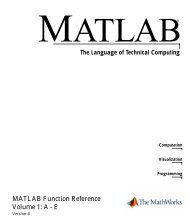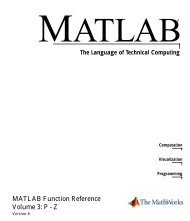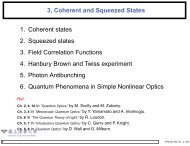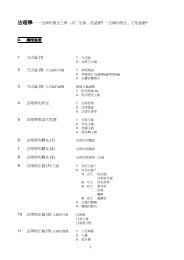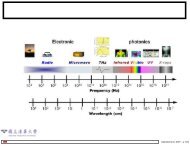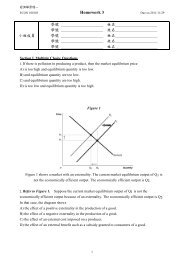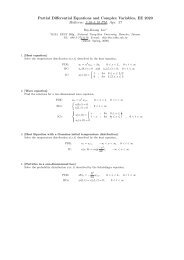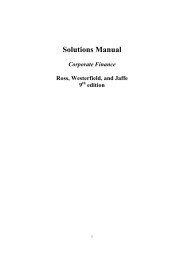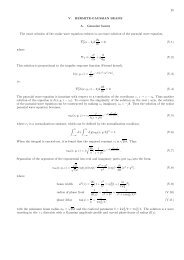You also want an ePaper? Increase the reach of your titles
YUMPU automatically turns print PDFs into web optimized ePapers that Google loves.
<strong>Acoustic</strong> <strong>Tweezers</strong>:<br />
A further study<br />
9512535 丁孝鈞
Outline<br />
• Introduction about acoustic tweezers<br />
• Method of acoustic tweezers<br />
• Mechanism of acoustic tweezers
Introduction to acoustic<br />
tweezers<br />
• <strong>Acoustic</strong> tweezers: Using acoustical<br />
method to trap small particles.<br />
• Method: With an single transducer to<br />
generate pulse wave to capture particles.<br />
transducer<br />
Sound wave<br />
Small particle
Introduction to acoustic<br />
Transducer<br />
input wave: continuous<br />
black: transmit<br />
red: reflect<br />
standing wave<br />
tweezers<br />
wall or<br />
surrounding<br />
standing wave is easily<br />
affected by surrounding
Method of acoustic tweezers<br />
First radiation force:<br />
<br />
F =< V∇ P><br />
For constant particle volume:<br />
<br />
<br />
∆p<br />
F = =< V∇ P>= V∇ < P><br />
∆t<br />
2<br />
⎧ T [sin(2θi − 2 θr) + Rsin(2<br />
θi)<br />
⎫<br />
Fg = V∇< P> ⎨Rsin 2θi<br />
−<br />
2<br />
⎬<br />
⎩ 1+ R + 2Rcos2θr⎭ 2<br />
⎧ T [cos(2θi − 2 θr) + Rcos(2<br />
θi)<br />
⎫<br />
Fs = V∇< P> ⎨1+ Rcos2θi<br />
−<br />
2<br />
⎬<br />
⎩ 1+ R + 2Rcos2θr⎭
Method of acoustic tweezers<br />
Flow chat<br />
Simulate the time course of acoustic field :P<br />
Calculate the gradient of the average P : ▽<br />
Calculate the force F<br />
Use the iteration method to find the track of the<br />
particle
Method of acoustic tweezers<br />
-30 ns to foci<br />
0 ns to foci<br />
30 ns to foci<br />
Gradient<br />
plot
Method of acoustic tweezers<br />
The net force of a particle<br />
The force-axis diagram at given time T
Method of acoustic tweezers<br />
Iteration method
Method of acoustic tweezers<br />
Track of particle<br />
Converge → S.H.M. → being captured
Method of acoustic tweezers<br />
Track converge<br />
Unbound<br />
track
Mechanism of acoustic tweezers<br />
1. Contact<br />
wave<br />
particle<br />
Trapping model<br />
2. Shake the particle<br />
particle
Mechanism of acoustic tweezers<br />
Trapping model<br />
3. Wave leaves the particle, and acoustic field<br />
exerts no force on particle during PRI .<br />
particle<br />
wave Position A Position B
Mechanism of acoustic tweezers<br />
Trapping model<br />
4. Viscosity will decrease the speed of particle<br />
particle<br />
v<br />
The force comes from viscosity
Mechanism of acoustic tweezers<br />
Initial<br />
condition<br />
ex: position<br />
density<br />
volume<br />
Mechanism of<br />
acoustic<br />
tweezers<br />
ex: wave form<br />
viscosity<br />
prf<br />
pressure<br />
..etc.<br />
Particle<br />
track
Mechanism of acoustic tweezers<br />
Particle contacts<br />
with wave<br />
first part<br />
Pulse-Trapping system<br />
work time<br />
second part (order): 10 4<br />
first part (order): 1<br />
Particle moves<br />
within PRI<br />
second part
Mechanism of acoustic tweezers<br />
First part<br />
When particle contacts with the sound wave<br />
⎡ 1 2 ⎤<br />
vt () ∆ t+ at () ∆t<br />
⎡xt ( +∆t)<br />
⎤ ⎡xt ( ) ⎤ ⎢ 2<br />
⎥<br />
⎢ ⎢ ⎥<br />
vt ( +∆ t) ⎥<br />
=<br />
⎢<br />
vt ( )<br />
⎥<br />
+ at ( ) ∆t<br />
⎢ ⎥ ⎢ ⎥ ⎢ ⎥<br />
⎢⎣at ( +∆ t) ⎥⎦ ⎢⎣at () ⎥⎦<br />
⎢ Axt ( ( +∆ t), t+∆t) −Axt<br />
( (),) t⎥<br />
⎢ ⎥<br />
⎣ ⎦<br />
A(x,t):=the acceleration at given time t and given position x
Mechanism of acoustic tweezers<br />
First part<br />
acceleration caused by viscosity<br />
acceleration caused by acoustic field<br />
When wave contacts with particle, viscosity can be ignored.
Mechanism of acoustic tweezers<br />
Second part :During PRI<br />
dv<br />
m =−kv<br />
dt<br />
dv k<br />
=− dt<br />
v m<br />
−k<br />
v = v0exp( t)<br />
m<br />
dx − k<br />
v = = v0<br />
exp( t<br />
dt m<br />
m ⎡<br />
∴ x(<br />
t ) = − v0<br />
exp(<br />
k ⎢<br />
⎣<br />
)<br />
− k<br />
m<br />
k = 6πµ<br />
r<br />
μ : viscosity<br />
r : particle radius<br />
m : particle mass<br />
This imply: When PRI becomes<br />
longer, no significant change<br />
occurs.<br />
⎤<br />
t ) − 1<br />
⎥<br />
+<br />
⎦<br />
x<br />
0
Mechanism of acoustic tweezers<br />
A tool which may be able to help study the<br />
system<br />
Phase plot
Mechanism of acoustic tweezers<br />
Phase plot<br />
When wave<br />
contacts with<br />
particle<br />
Particle moves<br />
Within PRI.<br />
PRI:0.001 s
Mechanism of acoustic tweezers<br />
Converge to the same point
Mechanism of acoustic tweezers<br />
Black: without viscosity<br />
Blue: with viscosity
Mechanism of acoustic tweezers<br />
Viscosity increase the chance of convergence<br />
The velocity of the particle: -1*10 -4 >2*10 -5
Mechanism of acoustic tweezers<br />
with viscosity<br />
all tracks converge to -25μm
Mechanism of acoustic tweezers<br />
Without viscosity<br />
Only three tracks converge<br />
viscosity<br />
increases the<br />
converge range
Conclusion<br />
• From the discussion above, viscosity<br />
plays an import role in the pulse<br />
trapping model.<br />
• Although viscosity takes part of the<br />
trapping model, the sound wave still<br />
dominate the whole system.<br />
• To obtain a better system stability, the<br />
waveform should be smooth.
Future work<br />
• To design a better waveform which may<br />
increase the stability<br />
• Study all factors such as density,<br />
particle size and pressure etc.<br />
• Study the stream flow which caused by<br />
acoustic pressure.
Thanks for your attention



